Vuk Marojevic
Federated Neuroevolution O-RAN: Enhancing the Robustness of Deep Reinforcement Learning xApps
Jun 15, 2025Abstract:The open radio access network (O-RAN) architecture introduces RAN intelligent controllers (RICs) to facilitate the management and optimization of the disaggregated RAN. Reinforcement learning (RL) and its advanced form, deep RL (DRL), are increasingly employed for designing intelligent controllers, or xApps, to be deployed in the near-real time (near-RT) RIC. These models often encounter local optima, which raise concerns about their reliability for RAN intelligent control. We therefore introduce Federated O-RAN enabled Neuroevolution (NE)-enhanced DRL (F-ONRL) that deploys an NE-based optimizer xApp in parallel to the RAN controller xApps. This NE-DRL xApp framework enables effective exploration and exploitation in the near-RT RIC without disrupting RAN operations. We implement the NE xApp along with a DRL xApp and deploy them on Open AI Cellular (OAIC) platform and present numerical results that demonstrate the improved robustness of xApps while effectively balancing the additional computational load.
Integrated LLM-Based Intrusion Detection with Secure Slicing xApp for Securing O-RAN-Enabled Wireless Network Deployments
Apr 01, 2025



Abstract:The Open Radio Access Network (O-RAN) architecture is reshaping telecommunications by promoting openness, flexibility, and intelligent closed-loop optimization. By decoupling hardware and software and enabling multi-vendor deployments, O-RAN reduces costs, enhances performance, and allows rapid adaptation to new technologies. A key innovation is intelligent network slicing, which partitions networks into isolated slices tailored for specific use cases or quality of service requirements. The RAN Intelligent Controller further optimizes resource allocation, ensuring efficient utilization and improved service quality for user equipment (UEs). However, the modular and dynamic nature of O-RAN expands the threat surface, necessitating advanced security measures to maintain network integrity, confidentiality, and availability. Intrusion detection systems have become essential for identifying and mitigating attacks. This research explores using large language models (LLMs) to generate security recommendations based on the temporal traffic patterns of connected UEs. The paper introduces an LLM-driven intrusion detection framework and demonstrates its efficacy through experimental deployments, comparing non fine-tuned and fine-tuned models for task-specific accuracy.
Enhanced Real-Time Threat Detection in 5G Networks: A Self-Attention RNN Autoencoder Approach for Spectral Intrusion Analysis
Nov 05, 2024



Abstract:In the rapidly evolving landscape of 5G technology, safeguarding Radio Frequency (RF) environments against sophisticated intrusions is paramount, especially in dynamic spectrum access and management. This paper presents an enhanced experimental model that integrates a self-attention mechanism with a Recurrent Neural Network (RNN)-based autoencoder for the detection of anomalous spectral activities in 5G networks at the waveform level. Our approach, grounded in time-series analysis, processes in-phase and quadrature (I/Q) samples to identify irregularities that could indicate potential jamming attacks. The model's architecture, augmented with a self-attention layer, extends the capabilities of RNN autoencoders, enabling a more nuanced understanding of temporal dependencies and contextual relationships within the RF spectrum. Utilizing a simulated 5G Radio Access Network (RAN) test-bed constructed with srsRAN 5G and Software Defined Radios (SDRs), we generated a comprehensive stream of data that reflects real-world RF spectrum conditions and attack scenarios. The model is trained to reconstruct standard signal behavior, establishing a normative baseline against which deviations, indicative of security threats, are identified. The proposed architecture is designed to balance between detection precision and computational efficiency, so the LSTM network, enriched with self-attention, continues to optimize for minimal execution latency and power consumption. Conducted on a real-world SDR-based testbed, our results demonstrate the model's improved performance and accuracy in threat detection. Keywords: self-attention, real-time intrusion detection, RNN autoencoder, Transformer architecture, LSTM, time series anomaly detection, 5G Security, spectrum access security.
LSTM-Based Proactive Congestion Management for Internet of Vehicle Networks
Oct 12, 2024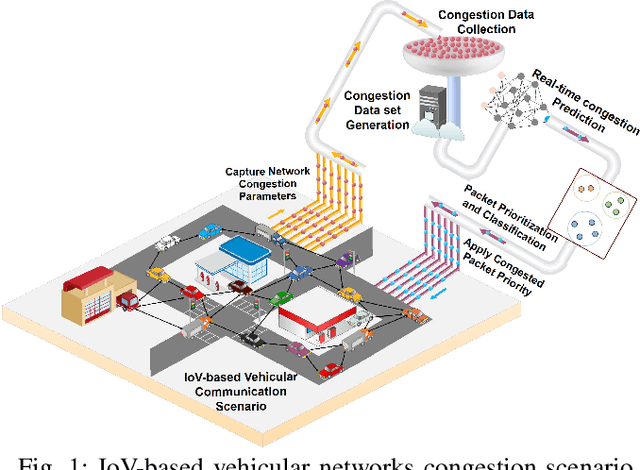
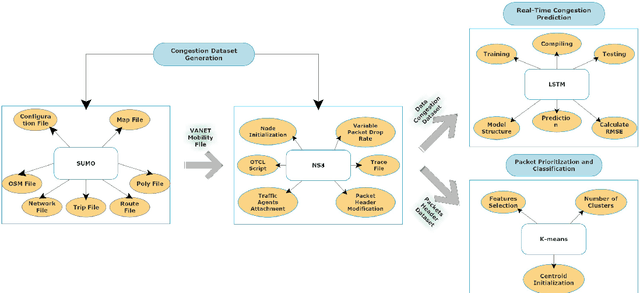
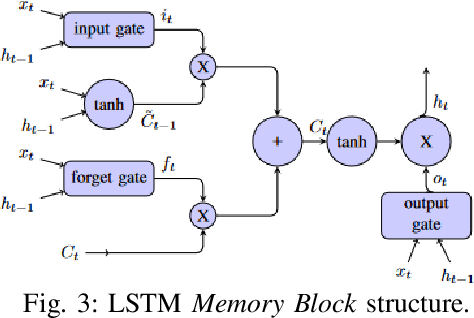
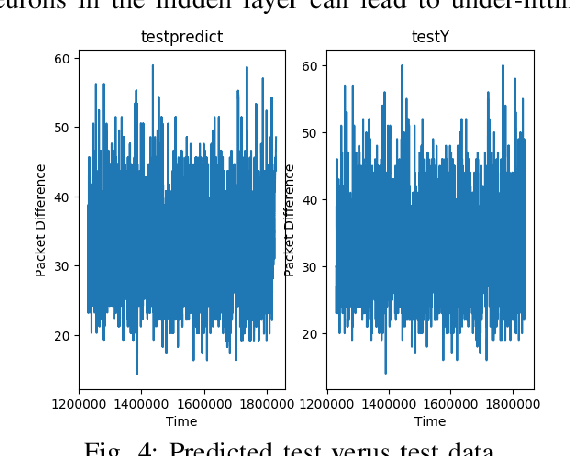
Abstract:Vehicle-to-everything (V2X) networks support a variety of safety, entertainment, and commercial applications. This is realized by applying the principles of the Internet of Vehicles (IoV) to facilitate connectivity among vehicles and between vehicles and roadside units (RSUs). Network congestion management is essential for IoVs and it represents a significant concern due to its impact on improving the efficiency of transportation systems and providing reliable communication among vehicles for the timely delivery of safety-critical packets. This paper introduces a framework for proactive congestion management for IoV networks. We generate congestion scenarios and a data set to predict the congestion using LSTM. We present the framework and the packet congestion dataset. Simulation results using SUMO with NS3 demonstrate the effectiveness of the framework for forecasting IoV network congestion and clustering/prioritizing packets employing recurrent neural networks.
5G Advanced: Wireless Channel Virtualization and Resource Mapping for Real Time Spectrum Sharing
Oct 08, 2023



Abstract:The coexistence between active wireless communications and passive RF spectrum use becomes an increasingly important requirement for coordinated spectrum access supporting critical services. The ongoing research and technological progress are focused on effective spectrum utilization including large-scale MIMO and energy efficient and low-power communications, innovative spectrum use and management, and resilient spectrum sharing, just to name a few. This paper introduces a new tool for real time spectrum sharing among emerging cellular networks and passive RF sensing systems used for remote sensing and radio astronomy, among others. Specifically we propose leveraging wireless channel virtualization and propose a virtual-to-physical resource mapping framework, mapping types, and control signaling that extends the current 5G New Radio (NR) specifications. Our technology introduces minimal changes to the protocol and is meant to be transparent to the end user application. We validate the proposed technology by extending a 3GPP compliant 5G NR downlink simulator and identify further research directions where work is needed on designing effective ways to explicitly signal the need for spectrum or spectrum use predictions.
UAV Trajectory and Multi-User Beamforming Optimization for Clustered Users Against Passive Eavesdropping Attacks With Unknown CSI
Jun 13, 2023Abstract:This paper tackles the fundamental passive eavesdropping problem in modern wireless communications in which the location and the channel state information (CSI) of the attackers are unknown. In this regard, we propose deploying an unmanned aerial vehicle (UAV) that serves as a mobile aerial relay (AR) to help ground base station (GBS) support a subset of vulnerable users. More precisely, our solution (1) clusters the single-antenna users in two groups to be either served by the GBS directly or via the AR, (2) employs optimal multi-user beamforming to the directly served users, and (3) optimizes the AR's 3D position, its multi-user beamforming matrix and transmit powers by combining closed-form solutions with machine learning techniques. Specifically, we design a plain beamforming and power optimization combined with a deep reinforcement learning (DRL) algorithm for an AR to optimize its trajectory for the security maximization of the served users. Numerical results show that the multi-user multiple input, single output (MU-MISO) system split between a GBS and an AR with optimized transmission parameters without knowledge of the eavesdropping channels achieves high secrecy capacities that scale well with increasing the number of users.
Actor-Critic Network for O-RAN Resource Allocation: xApp Design, Deployment, and Analysis
Sep 26, 2022
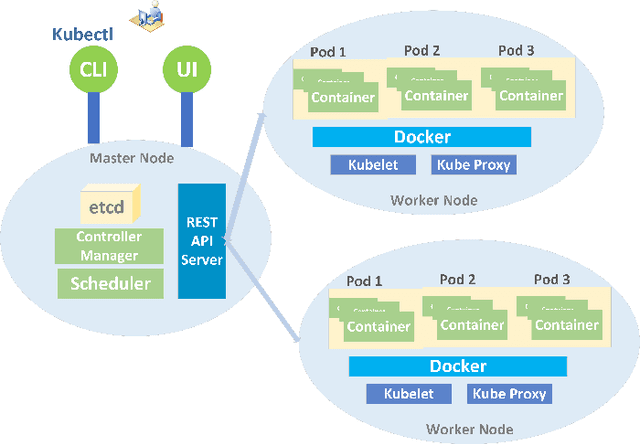
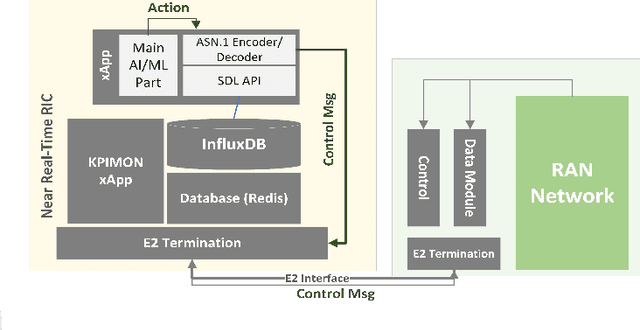

Abstract:Open Radio Access Network (O-RAN) has introduced an emerging RAN architecture that enables openness, intelligence, and automated control. The RAN Intelligent Controller (RIC) provides the platform to design and deploy RAN controllers. xApps are the applications which will take this responsibility by leveraging machine learning (ML) algorithms and acting in near-real time. Despite the opportunities provided by this new architecture, the progress of practical artificial intelligence (AI)-based solutions for network control and automation has been slow. This is mostly because of the lack of an endto-end solution for designing, deploying, and testing AI-based xApps fully executable in real O-RAN network. In this paper we introduce an end-to-end O-RAN design and evaluation procedure and provide a detailed discussion of developing a Reinforcement Learning (RL) based xApp by using two different RL approaches and considering the latest released O-RAN architecture and interfaces.
DDPG Learning for Aerial RIS-Assisted MU-MISO Communications
Jul 13, 2022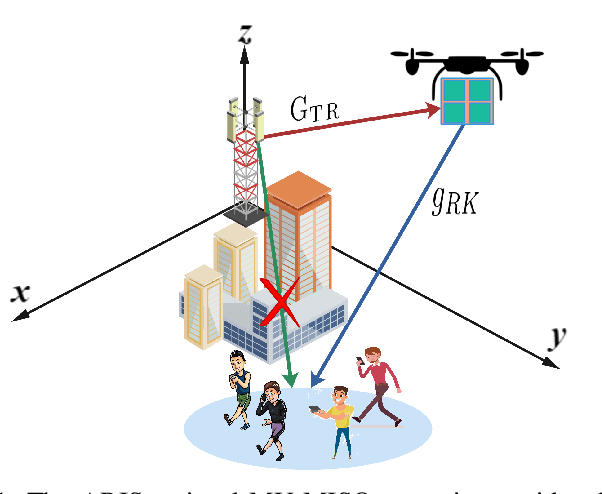
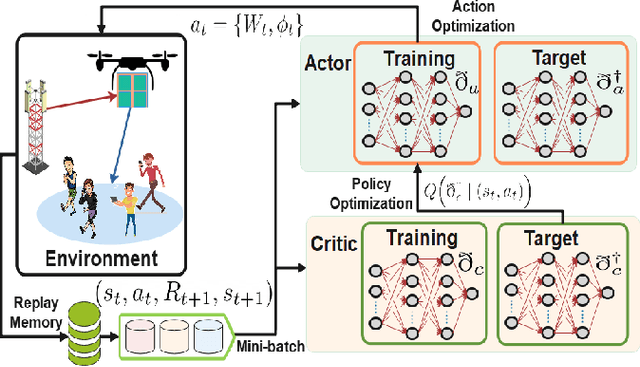
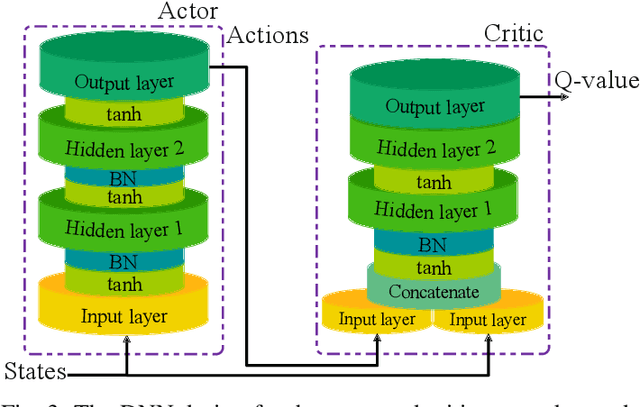

Abstract:This paper defines the problem of optimizing the downlink multi-user multiple input, single output (MU-MISO) sum-rate for ground users served by an aerial reconfigurable intelligent surface (ARIS) that acts as a relay to the terrestrial base station. The deep deterministic policy gradient (DDPG) is proposed to calculate the optimal active beamforming matrix at the base station and the phase shifts of the reflecting elements at the ARIS to maximize the data rate. Simulation results show the superiority of the proposed scheme when compared to deep Q-learning (DQL) and baseline approaches.
Self Interference Management in In-Band Full-Duplex Systems
Feb 01, 2022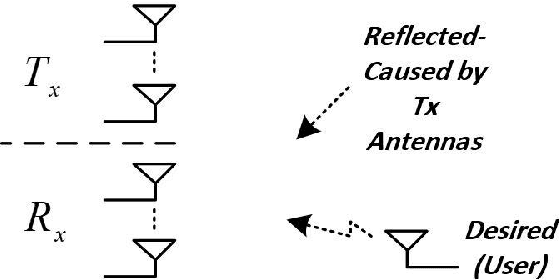
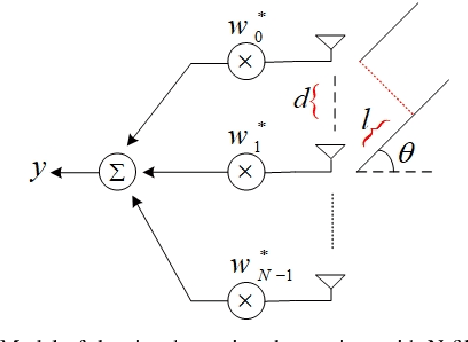
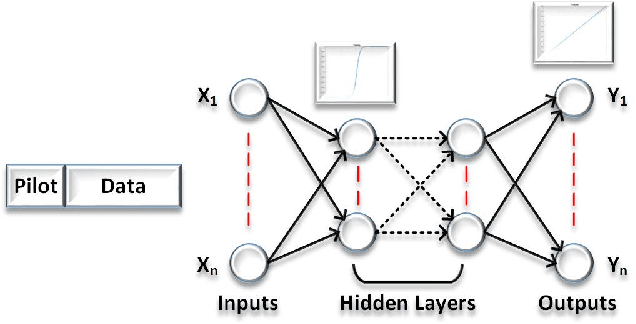
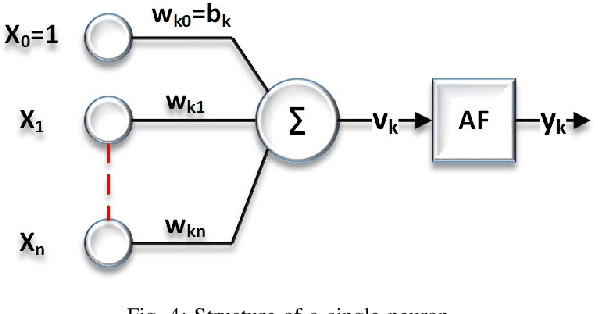
Abstract:The evolution of wireless systems has led to a continuous increase in the demand for radio frequency spectrum. To address this issue, a technology that has received a lot of attention is In-Band Full-Duplex (IBFD). The interest in IBFD systems stems from its capability to simultaneously transmit and receive data in the same frequency. Cancelling the self interference (SI) from the transmitter to the collocated receiver plays a pivotal role in the performance of the system. There are two types of SI cancellation (SIC) approaches, passive and active. In this research, the focus is on active cancellation and, in particular, SIC in the digital domain. Among the direct and backscattered SI, the former has been studied for a long time; therefore, the backscatter is considered in this research and two SIC approaches are analyzed. The first achieves SIC through beamforming. This requires knowing the angle of the received SI to put the beam null-space in this direction. The second method removes SI by employing an Artificial Neural Networks (ANNs). Using an ANN, there is no need to know the direction of the SI. The neural network is trained with pilots which results in the network being able to separate the desired signal from the SI at the receiver. Bayesian Neural Networks show the importance of the weights and assign a parameter that facilitates ignoring the less significant ones. Through comparative simulations we demonstrate that the ANN-based SIC achieves equivalent bit error rate performance as two beamforming methods.
AI-Driven Demodulators for Nonlinear Receivers in Shared Spectrum with High-Power Blockers
Jan 24, 2022

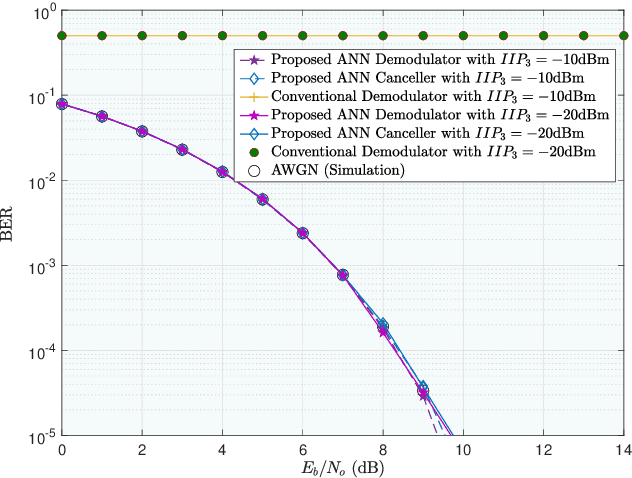

Abstract:Research has shown that communications systems and receivers suffer from high power adjacent channel signals, called blockers, that drive the radio frequency (RF) front end into nonlinear operation. Since simple systems, such as the Internet of Things (IoT), will coexist with sophisticated communications transceivers, radars and other spectrum consumers, these need to be protected employing a simple, yet adaptive solution to RF nonlinearity. This paper therefore proposes a flexible data driven approach that uses a simple artificial neural network (ANN) to aid in the removal of the third order intermodulation distortion (IMD) as part of the demodulation process. We introduce and numerically evaluate two artificial intelligence (AI)-enhanced receivers-ANN as the IMD canceler and ANN as the demodulator. Our results show that a simple ANN structure can significantly improve the bit error rate (BER) performance of nonlinear receivers with strong blockers and that the ANN architecture and configuration depends mainly on the RF front end characteristics, such as the third order intercept point (IP3). We therefore recommend that receivers have hardware tags and ways to monitor those over time so that the AI and software radio processing stack can be effectively customized and automatically updated to deal with changing operating conditions.
 Add to Chrome
Add to Chrome Add to Firefox
Add to Firefox Add to Edge
Add to Edge